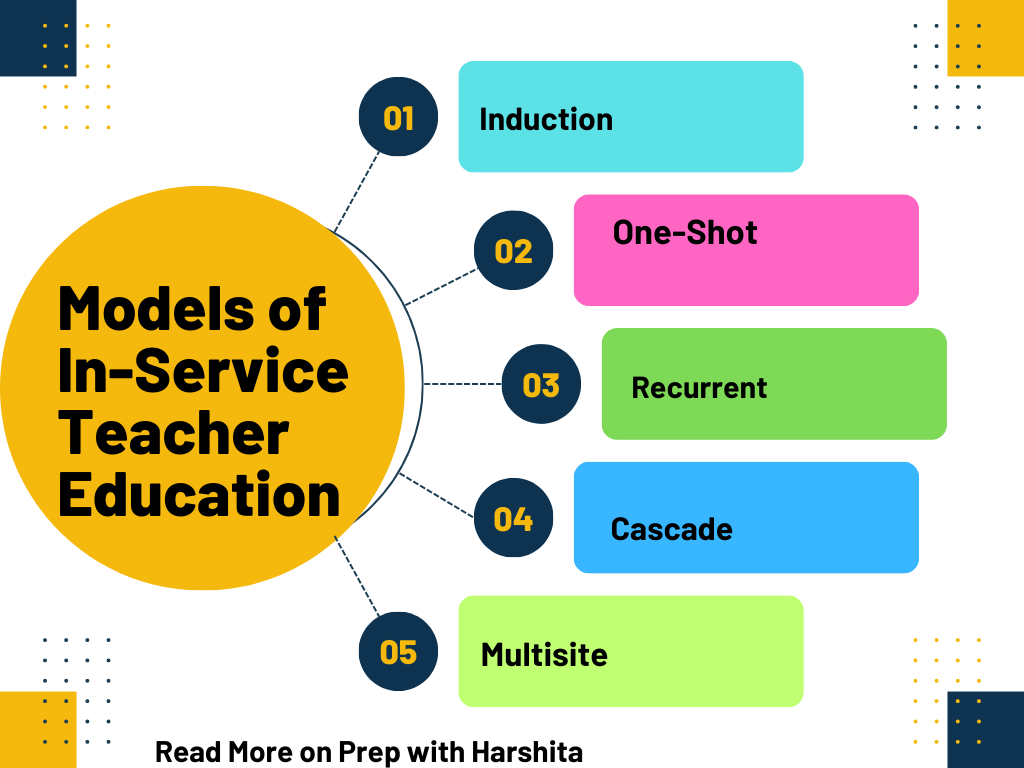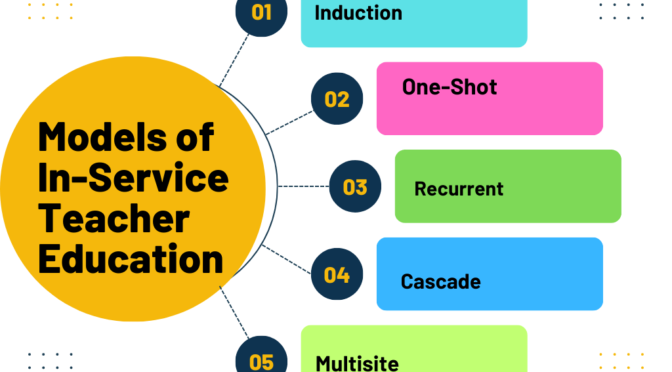In-service teacher training refers to professional development programs and activities designed for teachers who are already employed and actively teaching in schools. These programs aim to enhance teachers’ knowledge, skills, and instructional practices, keeping them updated with the latest research and pedagogical approaches.
There are several models of in-service teacher training that educational institutions and organizations employ. Here are a few common models:
- Induction: Induction programs are designed for newly hired teachers to help them transition smoothly into their teaching roles. These programs typically last for a specific period, such as one or two years, and provide support and mentorship to novice teachers. The focus is on familiarizing them with school policies, curriculum, instructional strategies, and classroom management techniques. Induction programs aim to build a strong foundation for new teachers and help them develop the necessary skills and confidence for effective teaching.
- One-shot: The one-shot model of in-service teacher training involves a single, isolated training session or workshop. It is usually a short-duration program that addresses a specific topic or skill. The training session may be conducted by an expert in the field or a resource person who specializes in the area being addressed. The one-shot model provides a targeted learning experience on a particular theme or strategy, but it may not allow for extensive follow-up or ongoing support.
- Recurrent: Recurrent in-service teacher training programs are characterized by regular and periodic training sessions conducted throughout the year. These programs aim to provide continuous professional development opportunities to teachers. The sessions can be conducted weekly, monthly, or at specific intervals, depending on the needs of the teachers and the organization. Recurrent training allows for more sustained and ongoing support, ensuring that teachers have the opportunity to deepen their knowledge and skills gradually.
- Cascade: Cascade training, also known as train-the-trainer model, involves training a group of educators who then become trainers themselves. The initial training is provided to a select group of teachers or educational leaders who possess expertise in a particular area. These trained individuals then disseminate the knowledge and skills to their colleagues or subordinates within the organization. Cascade training is effective for large-scale training initiatives, as it allows for the efficient distribution of knowledge across multiple levels within the educational system.
- Multisite: Multisite in-service teacher training involves collaborative efforts among multiple schools or educational institutions. This model brings together teachers from different locations or districts to participate in joint training programs. It promotes networking, sharing of best practices, and cross-pollination of ideas among educators from various contexts. Multisite training programs often involve workshops, conferences, or professional learning communities that enable teachers to connect and collaborate with peers from different schools.
- School-based: School-based in-service teacher training focuses on professional development activities conducted within the school or district. These programs are tailored to meet the specific needs and goals of the school community. School-based training can include various approaches, such as teacher-led workshops, lesson observations, collaborative planning sessions, peer coaching, or action research projects. The advantage of this model is that it aligns professional development with the specific context and priorities of the school, fostering a sense of ownership and relevance among teachers.
- Coursework: Coursework-based in-service teacher training involves enrolling in formal courses or academic programs offered by universities or educational institutes. These courses are often part-time or online, allowing teachers to continue their professional development while working. Coursework may cover a wide range of topics, including pedagogy, subject-specific content, assessment strategies, special education, or educational leadership. The coursework model provides a structured and systematic approach to professional development, offering theoretical knowledge and practical application opportunities.
It’s important to note that these models are not mutually exclusive and can be combined or adapted based on the specific needs and resources of an educational institution or organization. The choice of model depends on factors such as the goals of the training program, available resources, time constraints, and the preferences of the teachers and administrators involved.
Also Read: Modes of In-service Teacher Education

Also Visit: Prep with Harshita


hey there and thank you to your information ?I抳e definitely picked up anything new from proper here. I did alternatively expertise some technical points using this site, since I skilled to reload the website many times prior to I may get it to load properly. I had been considering if your web hosting is OK? Not that I’m complaining, however sluggish loading cases times will very frequently have an effect on your placement in google and could harm your quality ranking if ads and ***********|advertising|advertising|advertising and *********** with Adwords. Well I am including this RSS to my email and can look out for a lot extra of your respective interesting content. Ensure that you update this again soon..
Thank you for your sharing. I am worried that I lack creative ideas. It is your article that makes me full of hope. Thank you. But, I have a question, can you help me?
I would also like to say that most people who find themselves without having health insurance are generally students, self-employed and those that are not working. More than half of those uninsured are really under the age of Thirty-five. They do not feel they are in need of health insurance as they are young plus healthy. The income is frequently spent on houses, food, along with entertainment. A lot of people that do represent the working class either entire or in their free time are not made available insurance through their work so they go without due to the rising tariff of health insurance in america. Thanks for the thoughts you talk about through this blog.
A bGaming criou um jogo 3D incrivelmente realista. A jogabilidade também é um pouco diferente. Em cada rodada, você escolhe uma célula de uma linha de 5. Se você acertar a mina, o jogo termina. Se você tiver sorte, o jogo continua e a próxima linha é aberta. Você pode desistir a qualquer momento. A personalização do campo também está disponível. No entanto, não é possível escolher o número de minas – a cada vez, há apenas uma em uma linha. Depois de fazer experiências com ele, entendemos que um design cativante é a principal característica. Em outros termos, ele é bastante simples e pode ser entediante para jogadores experientes. Em resumo, o Mines é mais do que um simples jogo de aposta; é uma jornada emocionante repleta de estratégia e recompensas. Ao escolher o 1win como seu playground virtual, você se posiciona para uma experiência única e potencialmente lucrativa.
https://fitwell.qa/game-aviator-o-novo-portal-global-para-o-classico-das-apostas/
Ona Bet Famosos também tem falado sobre jogos online e dado dicas sobre os melhores jogos e melhores plataformas e o Ona bet Carlinhos Maia é um dos que mais interage com os jogadores. Famosos também tem falado sobre jogos online e dado dicas sobre os melhores jogos e melhores plataformas e o Ona bet Carlinhos Maia é um dos que mais interage com os jogadores. Ona Bet Famosos também tem falado sobre jogos online e dado dicas sobre os melhores jogos e melhores plataformas e o Ona bet Carlinhos Maia é um dos que mais interage com os jogadores. A reputação da Ona Bet é reforçada pelo fato de que a nossa empresa matriz, Esportes da Sorte, patrocina times de futebol brasileiros e apoia equipes de eSports. Isso demonstra a solidez financeira da empresa e sua capacidade de pagar prêmios aos jogadores em tempo hábil. A Onabet jogo de aposta também orgulhosamente conta com embaixadores da marca renomados, que ajudam a aumentar a visibilidade da marca e reforçar sua reputação como uma das plataformas mais confiáveis para jogos de azar online.